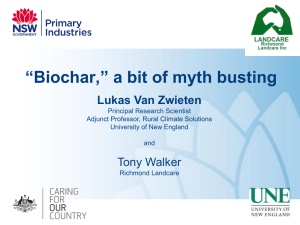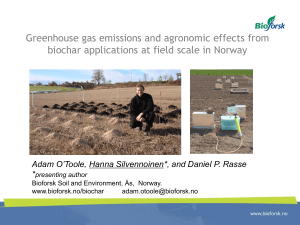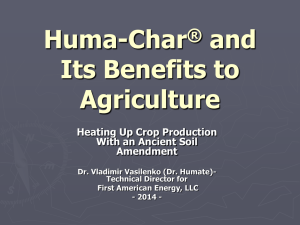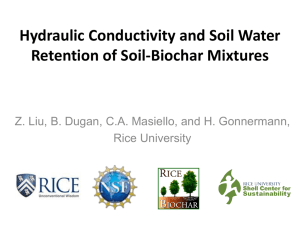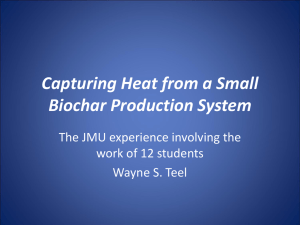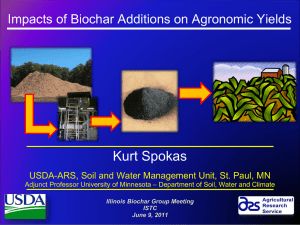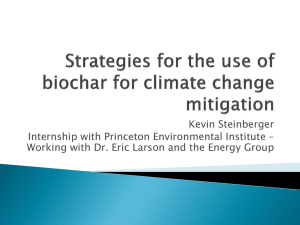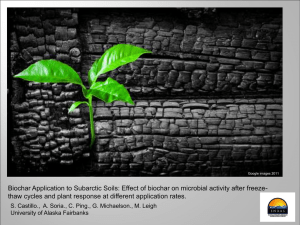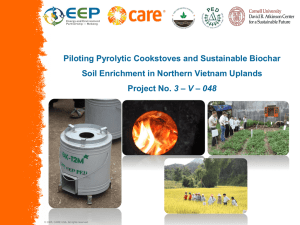Field trials biochar in norway 2011
advertisement
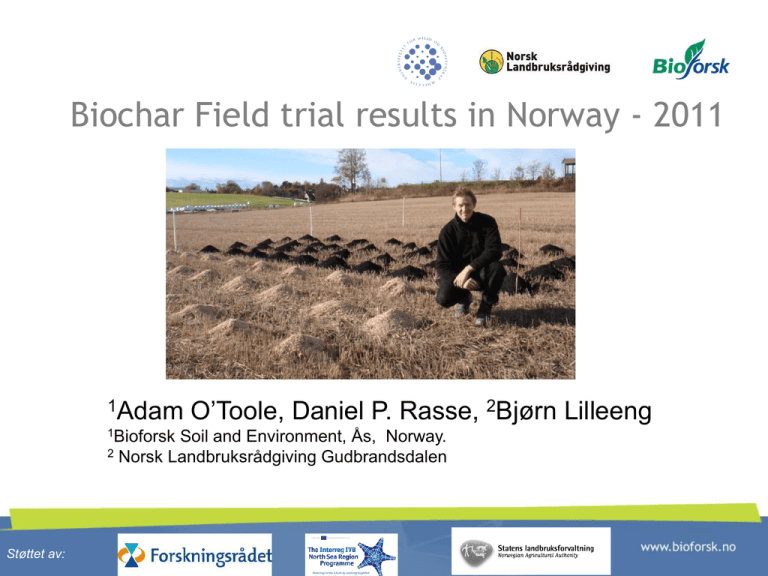
Biochar Field trial results in Norway - 2011 1Adam 1Bioforsk O’Toole, Daniel P. Rasse, 2Bjørn Lilleeng Soil and Environment, Ås, Norway. 2 Norsk Landbruksrådgiving Gudbrandsdalen Støttet av: Field trials in Norway - 2011 Sel Ås Notodden Introduction • Carbonizing biomass renders plant-C more resistant to biological breakdown – a feature making it attractive for increasing soil C stocks. Ås – Can biochar be used for carbon storage? • Biochar is a novel solution for increasing Soil C and reducing atomospheric CO2 …provided that it: • It is in fact stable, and leads to an overall increase in soil-C • Does not pose a risk to food production and soil health Purpose of study To estimate the stability of biochar-C and effects of biochar on native soil-C under field conditions Methods • C Stability: Measuringthe δ13C signature and CO2 efflux of a C3 soil after additons of Miscanthus (C4 plant) derived biochar C4 plants: ~ -15‰ Miscanthus δ13C Oats C3 SOM: ~ -30‰ Methods • Equipment: Closed static chambers, Infrared gas analyzer (IRGA) for CO2 efflux and Piccaro G1101-i for δ13C measurements) • Keeling plot method used to isolate soil respired CO2 in chamber measurements. Biochar and Soil description • Feedstock: Miscanthus giganteus (Elephant Grass) • Produced by Pyreg Gmbh (Germany) Pyroysis temperature 650-750 °C • Fixed C = 70% VM= 7% Ash= 23% • Total N: 2.5 g kg-1 • Total P: 1.3 g kg-1 • Total K:4.8 g kg-1 • pH: 10 • BET: 349 m2 g-1 • Soil: Inceptisol, Sandy Clay Loam, TOC: 2.5 % Field Trial • 2010-2013 • Biochar inverse ploughed in the fall of 2010 • 2011 crop: Oats • 2012 crop: Barley Experimental Design 16 plots - 4 treatments x 4 reps 1. 2. 3. 4. Miscanthus Biochar 8 t C ha-1 Miscanthus residue 8t C ha-1 Control – no amendments Miscanthus Biochar 25 t C ha-1 • Randomized block design Results Soil respiration 2011 0,800 0,700 g CO2 m-2 h-1 0,600 0,500 Miscanthus 8t C ha-1 Control 0,400 Biochar 8t C ha-1 0,300 Biochar 25t C ha-1 Average for season 0,200 0,100 0,000 17.05.2011 06.06.2011 26.06.2011 16.07.2011 05.08.2011 25.08.2011 14.09.2011 0.33C 0.32MC8 0.31BC8 0.29BC25 δ13 C measurements δ13 C SD (n=2) Control -29,8 0,4 Biochar 8 t -29,6 0,3 Biochar 25 t -29,4 2,0 Miscanthus 8 t -26,8 1,6 Contribution of C4 derived C to soil-C loss Oat grain yield (kg per dekar) 700 -5% 600 +6% Kg daa-1 500 400 300 200 100 0 Control MC8 BC8 BC25 No significant diff. Between treatments Straw yield DM (kg plot-1) 4,5 4,0 3,5 3,0 2,5 2,0 1,5 1,0 0,5 0,0 4,0 3,8 4,0 BC 8t C ha-1 BC 25 t C ha-1 3,5 Control MC 8 t C ha-1 No significant diff. Between treatments What can we conclude so far on soil and plant effects? Heavy metal content Biochar was well under the legal limits set for soil amendments in Norway Conclusion Preliminary first year results • Appeared relatively stabil and did not prime native C • Did not lead to decreased plant and grain yields • More years are required to establish a trend Interreg: Climate Saving Soils project Field Trial: Simmenstad Farm, Sel. Norway 2011-12 Experimental Design 16 plots - 4 treatments x 4 reps Fertilizer 1. Biochar 2t daa-1 10 kg N daa-1 2. Sludge 2t daa-1 6 kg N daa-1 3. Biochar 2t + sludge 2t daa-1 6 kg N daa-1 4. Control – no amendments 10 kg N daa-1 • Randomized block design A poor year for grain in Norway Photo: Karl Erik Berge (Nationen Flood in Gudbrandsdalen, June 2011 110 mm in one week (normal 50 mm/mth) 441mm from June 01 – Sept 29 (normal 228 mm) Soil erosion from the flood The field in July – flood effects Soil water and temperature effects Plant and grain yields Barley grain yield Sel 2011 Yield as compared to 5 year average barley yield (kg daa-1) 500 450 400 350 300 250 200 150 100 50 0 2007 2008 2009 2010 2011 (10%) Biochar Sludge BC + S Control Thanks for your attention Acknowledgements - Svend Pung – SKP, UMB - Toril Trædal (UMB) - Bjørn Lilleeng (NLR) Gudbrandsdalen - Kåre Simmenstad (farmer) - Christophe Moni, Farshad Tami and Robert Barneveld Funding: Matprogrammet, Norwegian Research Council. Interreg IV NSR program and SLF Our website: www.bioforsk.no/biochar


